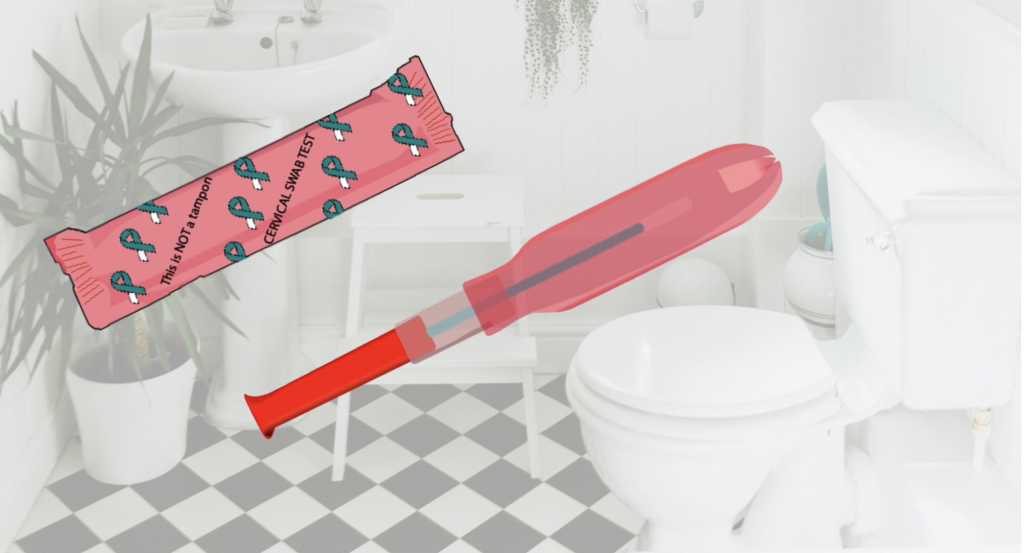On your marks, get set… Our MSc Healthcare and Design students take part in a Design Dash, a rapid design process to solve a real-world healthcare challenge. We spoke to two students, Aoife McGrath and Jasmine Banerjee, about the process.
A design dash is a rapid, collaborative method for conceiving tangible healthcare innovations. Our Helix Centre teaches and assesses the Design Dash module on the MSc Healthcare and Design course that is aimed at healthcare professionals and designers and co-run by Imperial College London and the Royal College of Art. The students work with Helix Centre’s researchers, designers and public engagement experts on a live rapid design project to prototype a solution to an identified challenge.

This year, the Design Dash focused on NHS screening programmes for cancer, which are important for both patients and the NHS, as detecting cancer early gives people a better chance of responding to treatment and therefore recovering from their illness.
The module starts with an action-packed week running through the Design Dash process, offering a chance to explore a new brief in an intense, collaborative and open-minded way. With an initial focus on bowel cancer screenings, the students were taken through the process of framing and dissecting briefs and understanding patients’ experiences. After the group projects, the individual assignment for the module was to create a project to increasing the uptake of breast or cervical screening.
While the end products of the Design Dash are only prototypes, by applying real-world design techniques that Helix Centre uses, the students gain knowledge that will stay with them throughout their careers.
Jasmine Banerjee, Product Designer and student on the Healthcare and Design MSc programme

I’ve come straight onto this master’s from doing an undergraduate in product design. I have a keen interest in medical technology and focused on this for all my undergraduate self-led projects.
The Design Dash week was fantastic, well organised and the content was brilliant. It was set up really well to teach us about important considerations for any design project, particularly for the students from a non-design background, such as by creating ‘how might we’ questions to help guide your research.
For my assignment, I chose breast screening as I had a whole range of expert patients that I could think to talk to. I also spoke to a GP who gave their interpretation of why there was low uptake and which patients they have to chase up to attend screenings. I was aware that people from ethnic minorities were less likely to attend screenings, and I wanted to consider how to approach these women. Based upon insights from my interviews with patients and my secondary research, the main barriers I identified were access to information, knowledge of what to expect and knowledge of their local unit.
“The main barriers I identified were access to information, knowledge of what to expect and knowledge of their local unit”
How might we make it easier for people to learn about the importance of screenings despite time constraints?
People often say they don’t have time to go to their screenings or have time to learn about it. So I thought, when is the time in a person’s life when they are ‘wasting time’ but have no other option? When they’re on public transport! I started looking at statistics about how long people spend on the tube during the commute and thought that using the London Underground was a good way of targeting every demographic.
I developed the ‘Boob Tube’, which is based on the London Underground, but the idea is for each tube line to be sponsored by, or working in partnership with, a breast cancer charity such as CoppaFeel!. Each carriage is filled with child friendly and religiously sensitive infographics, containing information on breast screening, what it is, what to expect, how to prepare for it, and why it’s important.

How might we prevent patients feeling uncomfortable with the level of nudity?
Alongside this, a lot of the people I interviewed said they felt discomfort with the level of nudity in front of healthcare professionals. So, I designed a boob tube top, with the ‘Boob Tube’ logo, which you can whip down and back up in-between each scan.
Breast cancer is one of the most common cancers, and screenings are an important way to protect yourself, but also in a secondary way, to protect your friends and family who care for you. They are there to provide you with reassurance and give you the best chance.”
Aoife McGrath is a senior microbiologist and student on the Healthcare and Design MSc programme
“I currently work as a Senior Microbiologist, on the development of consumer healthcare products.
The Design Dash was like a R&D sprint, from the early stage of understanding what the problem is, to creating final prototypes, all the while focusing on human-centred design. During the week, we spoke with people who had experience of bowel cancer screening, to first hand understand the concerns and feelings about the process. Getting those patients, users and experts involved from the beginning of the design process is hugely important and a key learning for designing in healthcare – you have to design with people at either end of the bell curve; you can’t just design for an average person.
“Getting patients, users and experts involved from the beginning of the design process is hugely important and a key learning for designing in healthcare”
For my own Design Dash research project, I chose to explore cervical screening, as I’m in the screening age bracket, so have first-hand experience and felt it would be easier to reach out to others. I created and shared an anonymous questionnaire, in addition to reaching out to my peers who were comfortable to speak on the subject, which enabled me to gather feedback about people’s experience with cervical screening.
A main theme identified through my research and interviews was a lack of education, people don’t fully understand why cervical screening is required or beneficial. More than one of the women I spoke to said ‘no one ever told us about this in school, we didn’t learn anything about it until I received the appointment letter in the post. Why are we not taught about this?’
There was also an issue of time, with NHS appointments typically being scheduled through the working day, resulting in people taking time off work. The subject of cervical screening or smear testing is rarely discussed, it’s a very personal topic and people don’t really talk about it. Thinking about this, other items such as sanitary products, tampons and contraception are readily available with less discomfort, but targeting the same area. Therefore, with my design, I tried to look at different aspects where I could improve three things – education, time and emotions.
How might we combine cervical screening awareness with sanitary products that are readily available, and something people are more comfortable with?
My design idea was to combine cervical screening swab samples with sanitary products. The idea would help educate people, making them more aware of cervical screening, and also reducing the time it takes to currently attend a screening appointment. During the COVID-19 pandemic, we were all doing our own swab sampling – to detect the virus. The cervical screening test used to detect the human papilloma virus, which can potentially lead to cancer, so why couldn’t we do cervical screening tests at home?

I read about the ‘small c’ campaign – YouScreen, where they have piloted a study of 30,000 women in North London, to assess if they could sample at home. 99% of those women were able to successfully and collect their own cervical sample, which was brilliant. The idea is you use a normal swab and then send it off to a lab like you would for a PCR COVID test. However, I thought, the swab might be a bit awkward, so how can we make this easier? So, my idea is to use the tampon applicator to help people take the sample. A tampon is something that is part of everyday life, therefore more comfortable and perhaps doesn’t seem as foreign as a swab.
My design also raises awareness of cervical cancer, having information about the importance of the screening on the packaging, with links of how to collect a sample with the special tampon applicator. Creating a rapid screening test, like COVID lateral flow tests, would simplify this further and anytime you buy a pack of tampons you can check from the comfort of your own home. A rapid cervical screening test is not yet available, but it is feasible to get there.
How might we use this design help people and healthcare systems?
Potentially this could take a burden off the NHS by reducing the amount of cervical screening tests the NHS needs to do. While also enabling the positive results to be detected sooner. It’s estimated that there has been a 70% reduction in cervical cancers from screening, but 83% of deaths could be prevented if everyone attended regularly. It’s a hugely important test to save lives, to empower women and people with a cervix to take control of their own health.
“It’s estimated that there has been a 70% reduction in cervical cancers from screening, but 83% of deaths could be prevented if everyone attended regularly.”
The Healthcare and Design course works directly with the NHS, and it’s a pivotal time to design efficient, frugal, clever solutions to help healthcare systems. Providing solutions to screenings, which prevents people from needing treatment, would be a huge help for people, but also healthcare systems in the UK and globally.”
Study our MSc in Healthcare and Design
Do you want to join us and use design thinking to solve problems in healthcare? Our MSc in Healthcare and Design is now open for applications, offering a hybrid teaching model so that you can learn flexibly at your own pace. Find out more about this course and how to apply on our website.

